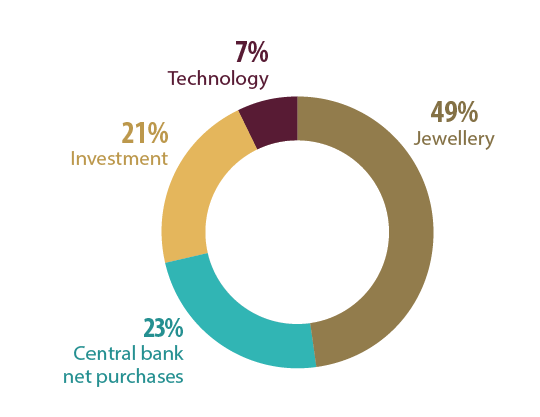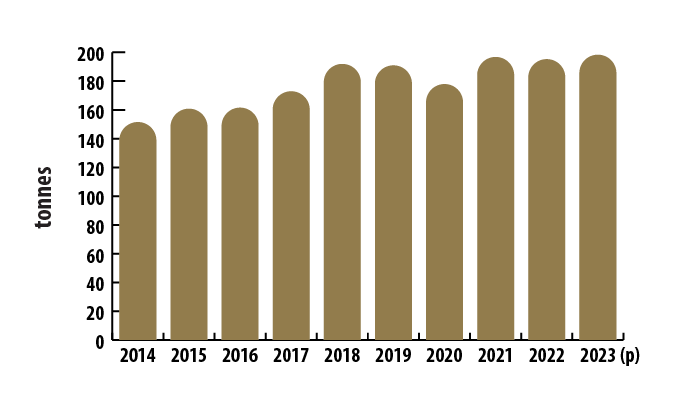
Gold is a precious metal commonly used for investments and jewellery (rings, necklaces, watches, etc.). Its superior electrical conductivity and resistance to corrosion also make it an important input in various electronic and technology applications.
Key facts
- Gold is Canada’s most valuable mined commodity, with a production value of $15.1 billion in 2023.
- Gold is mined in ten Canadian provinces and territories, mostly in Ontario and Quebec, which together accounted for 70% of Canada’s total gold output in 2023.
- In 2023, Canada ranked as the fourth-largest gold producer globally, with its mines yielding nearly 200 tonnes of gold.
Learn more about gold
 Uses
Uses
Jewellery remained the largest driver of global gold demand in 2023, accounting for 49% of total usage, or approximately 2,189 tonnes. Investment demand for gold, however, dipped by 4% compared to 2022, due to the higher opportunity cost of holding gold. Despite this decline, central banks continued to maintain significant gold reserves, spurred by ongoing economic uncertainties and inflationary pressures. Meanwhile, about 6% of global gold demand came from technology applications, primarily for use in micro-circuitry across various electronic products.
Gold uses, 2014–2023 (p)

Text version
This line graph illustrates the global demand for gold across various sectors from 2014 to 2023. The jewellery sector consistently dominated, accounting for 38% to 58% of demand, increasing slightly to 49% in 2023. Investment demand fluctuated significantly, ranging from 21% to 47%, but declined to 21% in 2023 after a notable spike in 2020. The technology sector’s demand remained relatively stable, between 7% and 8%, and ended at 7% in 2023. Meanwhile, demand from central banks and other institutions varied between 7% and 23%, stabilizing at 23% in 2023.
 Production
Production
Gold production from Canadian mines has steadily increased over the past decade, reaching 198 tonnes in 2023—a 2% increase from the previous year and 31% higher than in 2014.
Yukon saw a significant 49% rise in production in 2023, while most other provinces and territories, except Ontario, experienced slight decreases. Ontario and Quebec together accounted for 70% of Canada’s total gold production in 2023.
Canadian gold production, by region, 2023 (p)
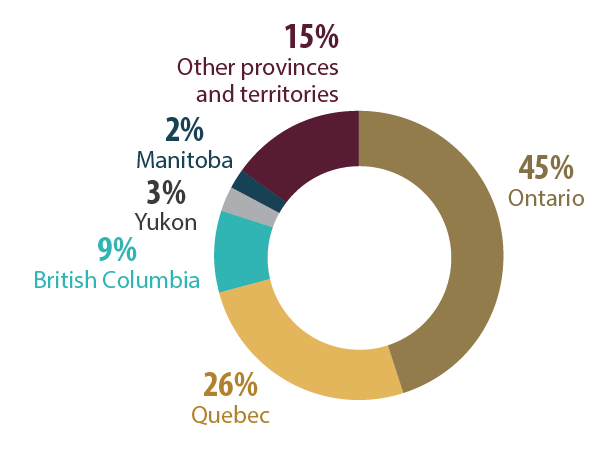
Text version
This chart illustrates Canada’s gold mine production for 2023. Ontario led with 89.9 tonnes (45%), followed by Quebec with 50.8 tonnes (26%), British Columbia with 17.9 tonnes (9%), Yukon with 6.6 tonnes (3%), and Manitoba with 3.8 tonnes (2%). The remaining provinces and territories collectively produced 30.2 tonnes (15%).
.png) International context
International context
Global gold mine production was estimated at 3,000 tonnes in 2023, almost equivalent to 2022 production.
The top five gold-producing countries accounted for 45% of the world’s annual gold output in 2023. Canada ranked fourth, with 6.7% of global mine production.
| Ranking | Country | Tonnes | Percentage of total |
|---|---|---|---|
| 1 | China | 370 | 12.3% |
| 2 | Australia | 310 | 10.3% |
| 3 | Russia | 310 | 10.3% |
| 4 | Canada | 200 | 6.7% |
| 5 | United States | 170 | 5.7% |
| 6 | Kazakhstan | 130 | 4.3% |
| - | Other countries | 1,300 | 43.3% |
| World total | 3,000 | 100.0% |
World gold mine production, 2014–2023 (p)
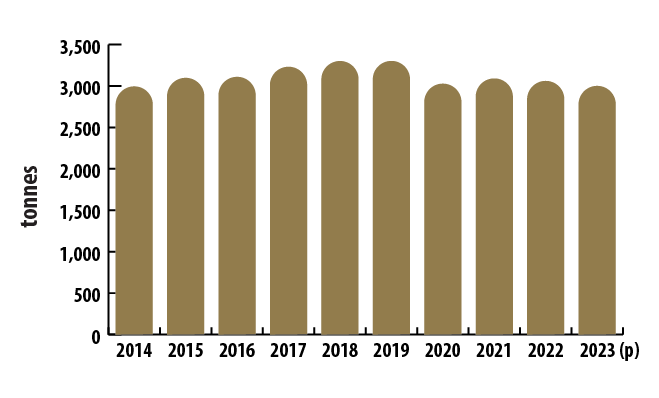
Text version
This bar graph illustrates global annual gold mine production from 2014 to 2023. In 2014, production was 2,994 tonnes. It gradually rose to 3,301 tonnes by 2019, then declined to 3,027 tonnes in 2020. After a slight uptick in the subsequent years, production fell again to 3,000 tonnes by 2023.
World reserves
Gold mineral ore reserve estimations are based on ore that can be considered reasonably, economically, and technically extractable at the time of estimation. According to the U.S. Geological Survey, world reserves of gold ore were estimated at 59,000 tonnes in 2023.
| Ranking | Country | Tonnes (thousands) |
|---|---|---|
| 1 | Australia | 12.0 |
| 2 | Russia | 11.1 |
| 3 | South Africa | 5.0 |
| 4 | United States | 3.0 |
| 5 | China | 3.0 |
| 6 | Indonesia | 2.6 |
| 7 | Brazil | 2.4 |
| 8 | Canada | 2.3 |
| - | Other countries | 17.6 |
| Total | 59.0 |
 Trade
Trade
Exports
- In 2023, the value of Canadian gold exports reached $30.2 billion, a 34% increase from $22.5 billion in 2022. This surge was fuelled by rising gold prices and strong demand from central banks seeking to diversify reserves and hedge against inflation and geopolitical risks. The market outlook suggests that if inflation stabilizes and interest rates fall, demand for gold could grow further as lower rates reduce the opportunity cost of holding non-yielding assets like gold, making it more attractive compared to interest-bearing investments such as bonds.
- Canada exported 100 tonnes of gold to the United Kingdom in 2023, accounting for 28% of Canada’s gold exports. The United Kingdom is a major importer of gold because of its role as a global financial hub for gold trade, where international investors purchase and sell gold via the London Bullion Market Association.
- Canada exported over 133 tonnes of gold to the United States in 2023, accounting for over 37% of Canada’s gold exports. This was an astonishing 221% increase from 2022.
- Canada’s exports of unwrought gold increased to 336 tonnes in 2023, up from 291 tonnes in 2022. The value of unwrought gold exports was $27.4 billion in 2022, increasing from $20.6 billion in 2022.
- The value of Canadian gold exports in metal ores and concentrates reached $1.3 billion in 2023, an increase of 8% over the previous year.
Imports
- In 2023, the value of gold imports in Canada was $17.7 billion, up from $14.6 billion in 2022.
- Canada imported 278 tonnes of unwrought gold in 2023, valued at $17.5 billion. This was a 4% decrease in quantity and a 22% increase in value compared to 2022.
 Prices
Prices
Gold prices have experienced considerable fluctuations over the past decade, ranging from as low as US$1,068 per troy ounce in December 2015 to a peak of US$2,029 per troy ounce in December 2023.
This increase was driven by strong demand from central banks and investors seeking to diversify reserves and hedge against inflation and economic uncertainty, a trend that began during the COVID-19 pandemic.
Gold prices, monthly average, 2014–2023
(US$/troy ounceFootnote *)
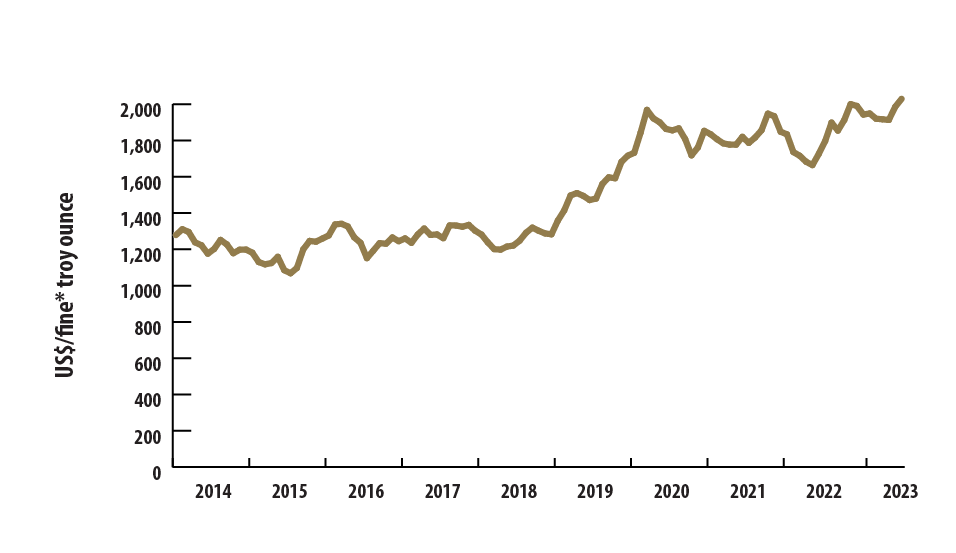
Text version
This line graph shows the monthly average gold price in US dollars per troy ounce from 2014 to 2023. Gold prices decreased from $1,245 in January 2014 to a low of $1,068 in December 2015. Prices generally increased between January 2016 and June 2019 before accelerating to reach a new peak price of $1,968 in August 2020. Declining slightly from the peak price, gold prices have fluctuated but remained relatively stable around $1,800 in 2022, increasing to $1,942 per troy ounce in 2023.
 Recycling
Recycling
Gold is continually being recycled, often in the form of old jewellery that is melted down for reuse. A major motivation for consumers to sell or hold on to their gold jewellery is the price of gold in their respective currencies.
When gold prices rise, it usually increases the supply that is available for scrap (recycled gold). The recycled gold supply in 2023 was 1,239 tonnes, a 9% increase from 2022.
Recovering gold from end-of-life electronics is an additional and major contributor to the global scrap supply.
Notes and sources
(p) preliminary
Totals may be different because of rounding.
All dollars are Canadian unless otherwise indicated.
Uses
- Gold uses, 2014–2023 (p)
- World Gold Council
- Gold demand, 2023 (p)
- World Gold Council
Production
- Canadian gold production, by region, 2023 (p)
- Statistics Canada
- Suppression of confidential data by Statistics Canada renders production numbers for some provinces unavailable.
- Canadian gold production, 2014–2023 (p)
- Natural Resources Canada; Statistics Canada
International context
- World gold mine production, by country, 2023 (p)
- Natural Resources Canada; Statistics Canada (Canadian Statistics)
- U.S. Geological Surveys
- World gold mine production, 2014–2023 (p)
- Natural Resources Canada; Statistics Canada (Canadian Statistics)
- U.S. Geological Surveys
- World reserves of gold, by country, 2023 (p)
- U.S. Geological Surveys
Trade
- Imports and exports of Canadian gold, 2023 (p)
- Natural Resources Canada; Statistics Canada
- Mineral trade includes ores, concentrates, and semi- and final-fabricated mineral products.
Prices
- Gold prices, monthly average, 2014–2023
- The London Bullion Market Association (PM Fix)
Recycling
- Recycled Gold Supply, 2023
- Metals Focus
